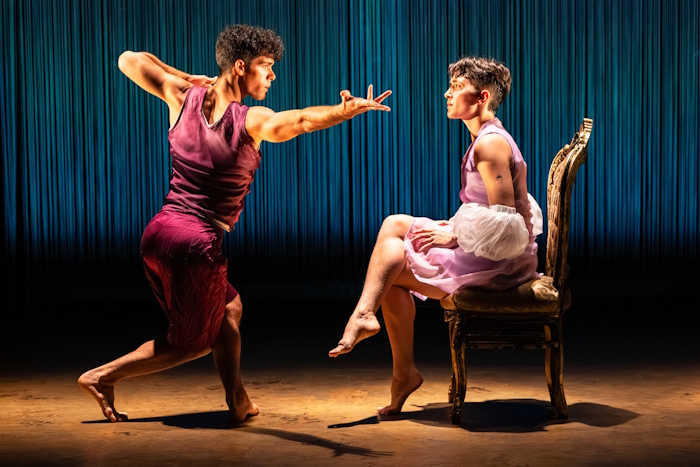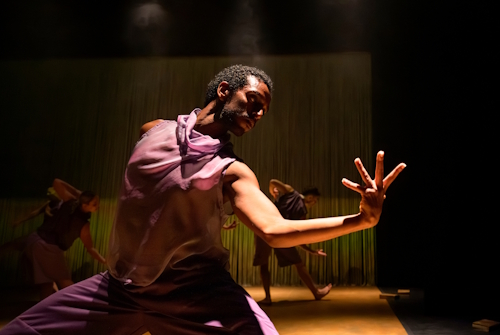Shobana Jeyasingh Dance, Mayflower Studios, Southampton
October 2, 2025
Shakespeare’s The Tempest (one of only two of his play plays whose plot is entirely his invention, the other being A Midsummer Night’s Dream), has been reimagined in ballet many times, less often in contemporary dance, although there are a few versions around, notably that by Crystal Pite. It’s easy to see why it should appeal. The title is recognisable, it’s got magic, a dramatic shipwreck, youthful lovers, sprites and spirits, but the subplots are terribly complicated and main characters’ motivations rather unclear.
If that wasn’t enough, the story is writ through with the attitudes regarding class, race that are problematic today, not too surprising given the play was written at the time European nations were starting out on the road of colonialism. And then there’s the position of women in society. Miranda is the only significant female character, and even she seems to be there for her virginity.
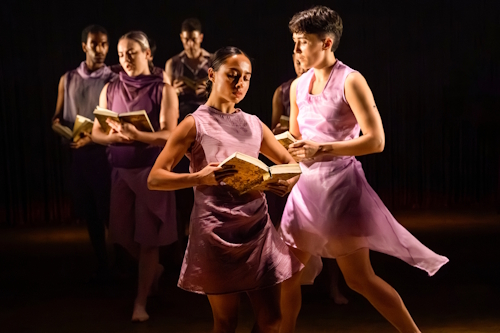
l-r: Natnael Dawit, Tabitha O’Sullivan, Oliver Mahar, Tanisha Addicott,
Julia Costa (hidden), Holly Vallis
Photo Foteini Christofilopoulou
Shobana Jeyasingh deals deftly with all those issues in her new We Caliban, a sideways look at the story and in which she comes at things largely through the eyes of Caliban, the only human inhabitant of the island until the shipwreck of the Duke of Milan. Wisely, she does not attempt to tell the whole story, although there are scenes of narrative, and some knowledge of the play is a distinct advantage.
The cast of eight danced admirably. The switching of some between chorus or ensemble work and named roles is not remotely confusing.
And it is with an ensemble dance, in which much use is made of books, that the work opens. Given Will Duke’s projections that suggest the sun glistening on a gentle sea, and the sound of birds, the inference is that we are on some warm paradise island, although it’s not totally clear. Natnael Dawit stood out in particular here, dancing with lithe grace.
Those projections and accompanying spoken text later include Elizabeth I’s letters patent to Sir Walter Raleigh, a long list of Caribbean islands, and words associated with colonisation. ‘Cunning’, ‘Base’ and ‘Degenerate’ and a reference to the ‘universality of depravity’ speak loudly of attitudes.
After flipping to Italy and a visualisation of the overthrow of the Prospero, Duke of Milan (Gabriel Ciulli) by Antonio (Oliver Mahar), Jeyasingh gets to the meat of the evening. Now she puts the focus very much on Caliban, danced strikingly by Cuban choreographer-dancer Raúl Reinoso Acanda, perhaps best known for his work with Acosta Danza.
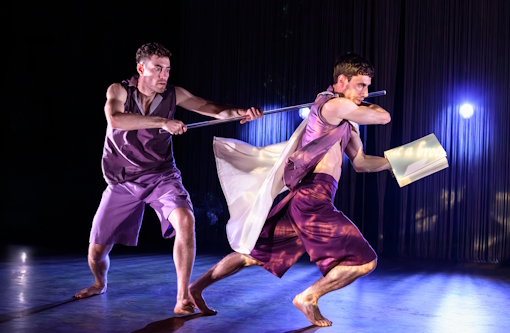
in Shobana Jeyasingh’s We Caliban
Photo Foteini Christofilopoulou
The best moments come in two duets, first with Holly Vallis’ Miranda, then, after everyone else has left the island, with Tanisha Addicott, who represents the original occupants of the island, Caliban is not being the only human resident in this telling. I’m not entirely convinced there’s enough to allow the viewer to come to understand him in depth, but we do see him from a very different perspective. Far from being a grotesque, uncivilised brute, a monster or creature of nature, he’s shown as being rather like the rest of us, with the same needs and desires.
The long duet with Miranda is far from tempestuous and lacks much in the way of emotion. It is very much a coming together of equals however, with Caliban depicted sensitively and with a slight air of innocence. There’s certainly no sense of him being insolent, rebellious or uncivilised in any way. Miranda shows empathy as we see how the pair try to come to understand each other despite being separated by language. Just how much they are the same as any other couple is shown when the roll on the floor in embrace, as two other pairs do likewise.
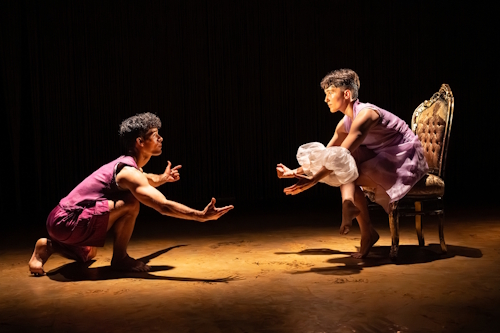
in Shobana Jeyasingh’s We Caliban
Photo Foteini Christofilopoulou
Reinoso Acanda and Vallis are very, very good, even outdoing the closing duet for him and Addicott, which flows beautifully, concluding the evening on a pleasing note, although the end does come very suddenly and unexpectedly.
Duke’s projections are excellent throughout, although I’m not at all sure they provide as many signposts for the viewer as hoped. I also had problems hearing the text clearly at times. Floriaan Ganzevoort’s lighting is atmospheric but is also very dark. Faces are frequently hidden in shadow with even whole bodies sometimes disappearing into the gloom. Thierry Pécou’s music for virtual orchestra and processed sounds is pleasant if not especially memorable.
We Caliban is a work that both fascinates and confuses, although things did become clearer afterwards and on reflection. Indeed, I suspect one might get more out of it on a second viewing. Focusing in on Caliban is an unusual step, but one that works well, as do the links with colonialism. I just wish we had seen even more of the titular character, found greater depth. But definitely worth a look.
Shobana Jeyasingh’s We Caliban continues on tour. Click here for details.

